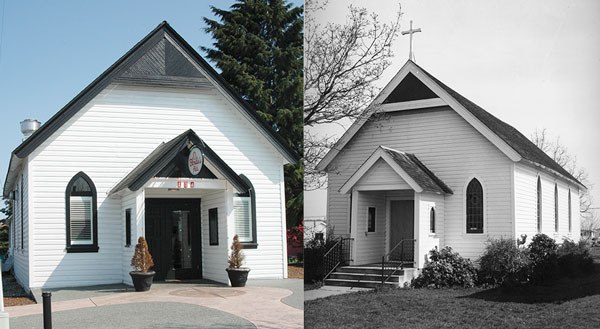With time a handful of Sequim’s landmark structures have aged, yet still stand as quiet reminders of the past. In this series Gazette staff take a step backward in time to compare these structures now from then and revisit the history, giving insight into the area’s early development.
The building that now houses Blondie’s Plate, a local restaurant, is a far cry from its time of construction 122 years ago.
Construction of the small white building began in 1893 and was completed three years later, making it one of the earliest churches and the first Episcopal church in Sequim. The creation of the St. Luke’s Episcopal Church was spurred by New Yorker and doctor Sarah Hucksford who moved to Sequim after marrying a sea captain, Thomas Jones.
“Mrs. Jones was a remarkable woman with a wonderful memory, a strong personality and much more,” Margaret Godfrey wrote in her report of the history of St. Luke’s Episcopal Church.
Having moved to Sequim as an Episcopalian, but with no church to attend, Sarah Jones built one on their property about a mile north of the city. Although Jones initiated the effort to construct the church, she was not alone as many members of the community came together to make it a reality.
Despite being incomplete, the first service held at the former St. Luke’s Episcopal Church was in 1894.
Born in Sequim in 1939, Sally Sue Barry’s first fond memories of the church date back to when she was a young girl attending Girl Scout Brownie Troop meetings there and can recall going through her Brownie initiation just outside the church. Although she didn’t attend the church until the 1960s, Barry said, “It was a beautiful building.”
After the Joneses sold their property in 1908, the church was moved to a lot along North Sequim Avenue gifted by the longtime Sequim-Dungeness family, the Seals.
“The task of moving the church involved narrow roads, winding among the trees, little to no regular equipment, making it a big project,” Godfrey wrote. “Such great care was taken that not a crack appeared in the large window over the alter or the windows in the nave – a remarkable accomplishment considering the very rough roads they had to travel.”
According to Godfrey, the contract to move the church during the early 1900s was $80.
Having made it through the move unharmed, the church remained along North Sequim Avenue and served as the community’s Episcopal Church until its walls were outgrown and time began to take its toll.
Attending church service in the elderly building was “interesting,” Sue Clary, a member of St. Luke’s Episcopal Church since 1976, said. “You could feel it sway in the wind. It had rods running across to help hold the walls in place.”
Another longtime church member Annie Gilbert remembers the past St. Luke’s Episcopal Church as “small, but beautiful, with a peaceful ambience,” she said.
Despite the small church’s seemingly ageless charm, in 1992 a larger structure took on the role of St. Luke’s Episcopal Church and the historical building was deconsecrated during a summertime Sunday ceremony.
“It was kind of sad to leave,” Gilbert said. “There was a closeness and comfort with that church.”
By 1996, the building again found its way onto wheels and was taken deeper within the city’s limits to Heritage Square at Second Avenue and Bell Street. In order to relocate the building, several downtown streets were shut down and telephone wires were lifted for safe passage.
No longer a sacred space, the building was transformed into Jean’s Deli before it eventually become Lipperts’ Restaurant in 2005 and most recently Blondie’s Plate.
From its exterior, the white, oblong building still resembles the shape of a church, but inside a oven has taken the place of where the organ once sat.
To see the building in town “brings back great memories,” Gilbert said.
Though it is no longer a place of worship, the historical building remains within the community for more great memories to be had.



